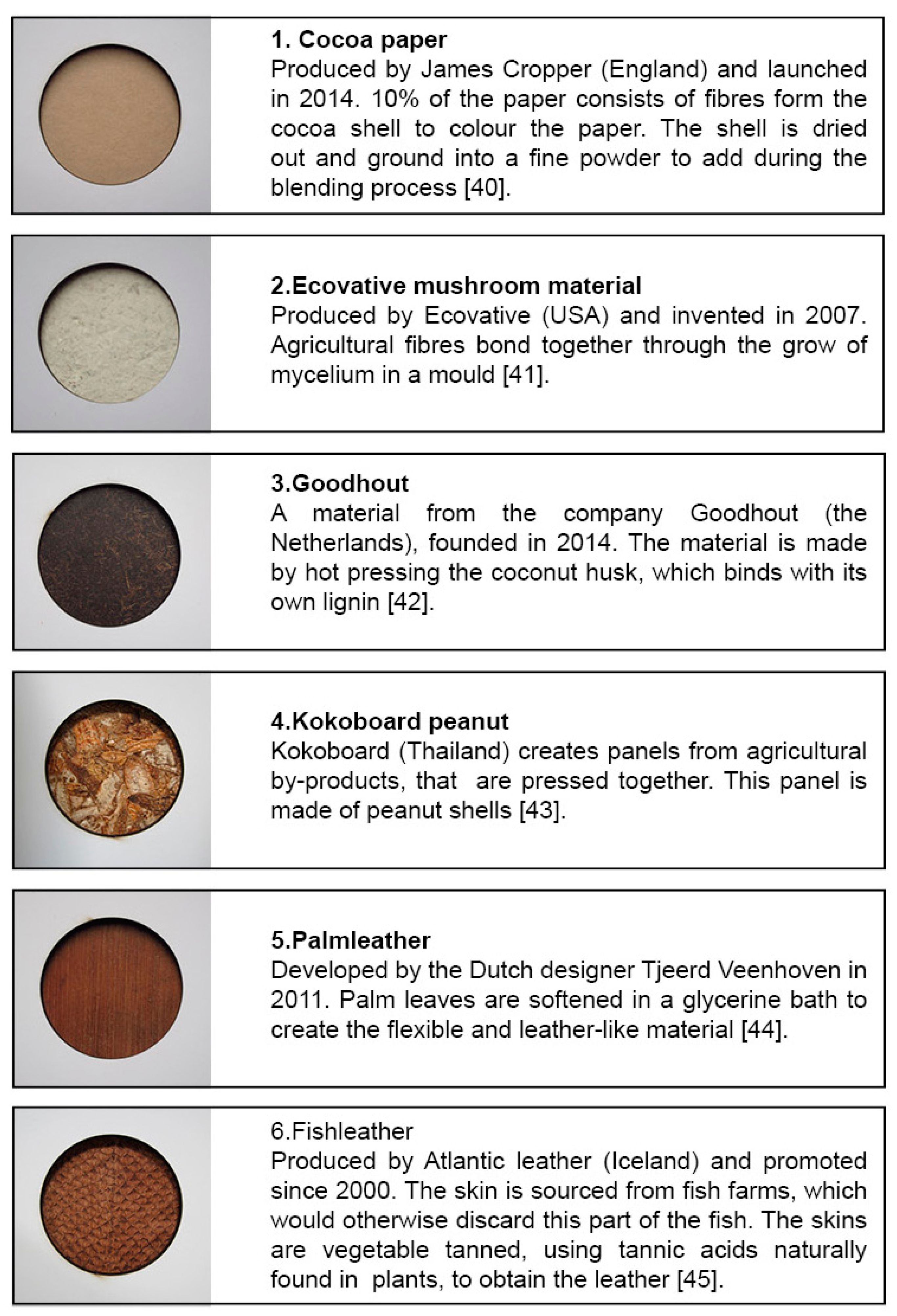Revived Beauty: Research into Aesthetic Appreciation of Materials to Valorise Materials from Waste
Abstract
:1. Introduction
2. Method
3. Aesthetic Pleasure in Design
4. Preliminary Study: Selection of the First Set of Revived Materials
5. Study 1: When Is a Material Appreciated as Beautiful? When Do Designers Want to Design with a Material?
5.1. Method
5.2. Results
6. Material Modification: Developing a New Set of Material Samples for Study 2
7. Study 2: Do the Created Material Samples Represent Similarity or Contrast as Intended? Are They Aesthetically Appreciated?
7.1. Method
7.2. Results of Study 2
8. Discussion
9. Conclusions
Acknowledgments
Author Contributions
Conflicts of Interest
Appendix A
| Revived Material | Description |
|---|---|
Bagasse paper | A by-product of the production of sugarcane sugar. The production process of this paper is similar to that of conventional paper [52]. |
Biolaminate | Developed by the Dutch designer Tjeerd Veenhoven in 2012. The plant fibres are bonded by a potato starch through cold pressing [53]. |
Biopolymer | Produced by FluidSolids since 2012. The material is made of fibre, filling materials and a binding agent. All these materials are generated as industrial waste in the processing of renewable materials. They are coloured with natural pigments, available in several colours [54]. |
Cocoa paper | Produced by James Cropper and launched in 2014. Ten per cent of the paper consists of fibres form the cocoa shell to colour the paper. The shell is dried out and ground into a fine powder to add during the blending process [40]. |
Ecoboard | Sold by Maiburg since 2008 and produced in China. To produce the material, the agricultural residues are boned together with the natural lignine of the cellulose fibres with a three per cent additive [55]. |
Ecovative | Produced by Ecovative and invented in 2007. Agricultural fibres bond together through the growth of mycelium in a mould [41]. |
Goodhout | A material from the company Goodhout, founded in 2014. The material is made by hot pressing the coconut husk, which binds with its own lignin [42]. |
Kokoboard peanut and rice  | This company creates panels from agricultural by-products that are pressed together. They use rice, peanuts, straw, coco dust and vetiver grass [43]. |
Novofibre | Produced by the company Novofibre and introduced in 2009. The material is produced by mixing straw with maximal 5% p-MDI through a hot press process. P-MDI is a resin, free from formaldehyde. Currently Novofibre is trying to replace this resin for ACRODUR, but this is under development [56]. |
Organoid decorative coating | These coatings are produced by Organoid in Austria since 2012. Different natural and authentic source materials are bonded by a biodegradable binder to receive a decorative surface. A special effect of these coatings is that they spread their natural scent [57]. |
Palmleather | Developed by the Dutch designer Tjeerd Veenhoven in 2011. Palm leaves are softened in a glycerine bath to create the flexible and leather-like material [44]. |
Treeplast | Produced by the Dutch designer Paul Eilbracht since 1999. The material is made from wood chips, lignite, crushed corn (starch) and natural resins [58]. |
Fishleather | Produced by Atlantic leather and promoted since 2000. The skin is sourced from fish farms, which would otherwise discard this part of the fish. The skins are vegetable tanned, using tannic acids naturally found in plants, to obtain the leather [45]. |
Appendix B
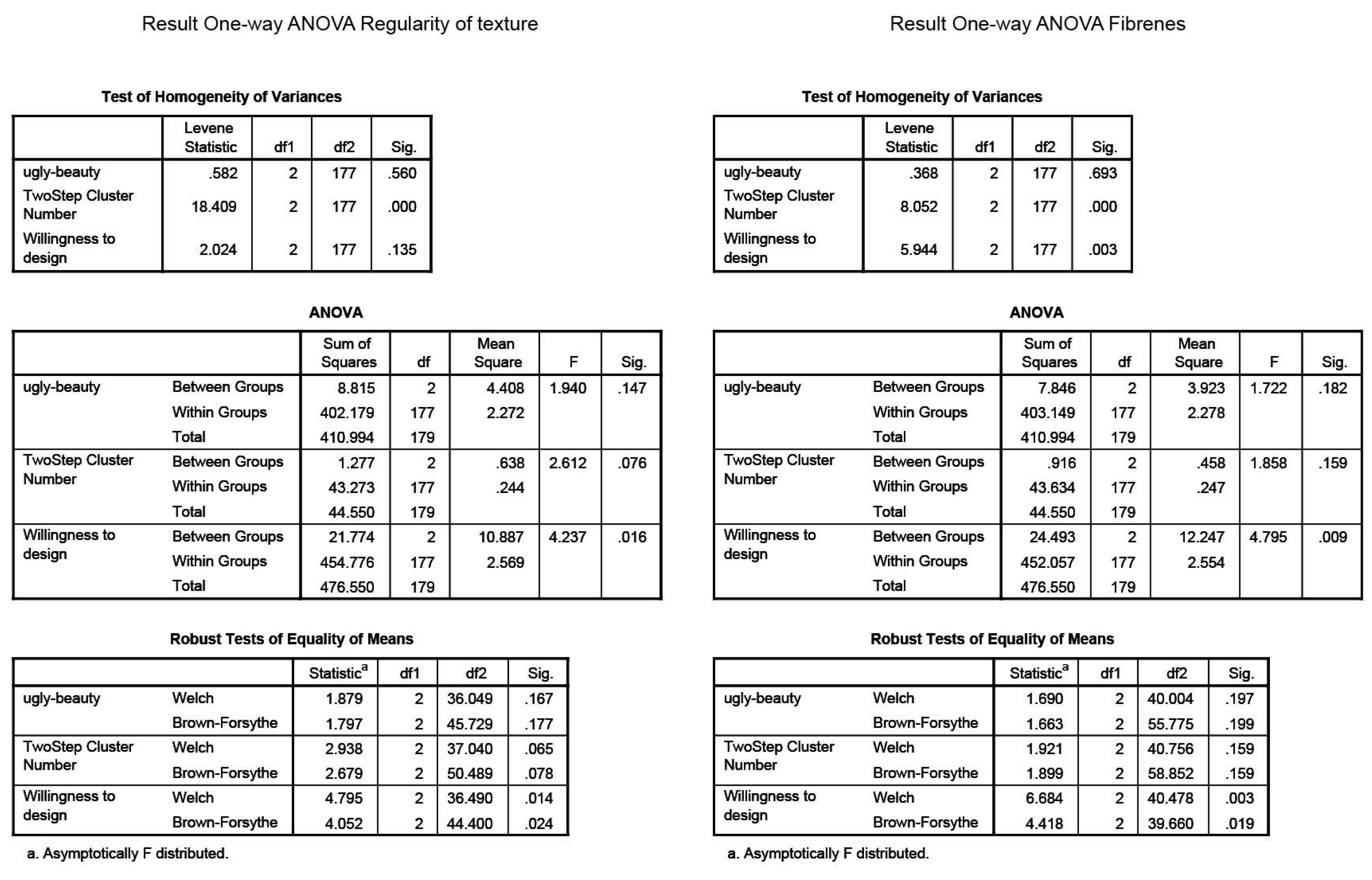
References
- Freinkel, S. Plastic: A Toxic Love Story. J. Soc. Hist. 2013, 46, 811–814. [Google Scholar]
- Geiser, K.; Commoner, B. Materials Matter: Toward a Sustainable Materials Policy; MIT Press: London, UK, 2001. [Google Scholar]
- Karana, E. Characterization of “natural” and “high-quality” materials to improve perception of bio-plastics. J. Clean. Prod. 2012, 37, 316–325. [Google Scholar] [CrossRef]
- Papanek, V. Design for the Real World: Human Ecology and Social Change, 2nd ed.; Chicago Publishers: Chicago, IL, USA, 1985. [Google Scholar]
- Terry, B. Plastic-Free: How I Kicked the Plastic Habit and How You Can Too; Skyhorse publishers: New York, NY, USA, 2012. [Google Scholar]
- Ljungberg, L.Y. Materials & Design Materials selection and design for development of sustainable products. Mater. Des. 2005, 28, 466–479. [Google Scholar]
- Rognoli, V.; Milano, P.; Salvia, G.; Milano, P.; Levi, M.; Milano, P. The aesthetic of interaction with materials for design: The bioplastics identity. In Proceedings of the Designing Pleasurable Products and Interfaces, Milano, Italy, 22–25 June 2011; ACM: New York, NY, USA, 2011. [Google Scholar]
- Rognoli, V.; Karana, E. Toward a new materials aesthetic based on imperfection and graceful aging. In Materials Experience: Fundamentals of Materials and Design; Karana, E., Pedgley, O., Rognoli, V., Eds.; Butterworth-Heinemann: Oxford, UK, 2014; pp. 145–154. [Google Scholar]
- Saito, Y. Everyday Aesthetics; Oxford University Press: New York, NY, USA, 2007. [Google Scholar]
- Stegall, N. Designing for sustainability: A Philosophy for Ecologically Intentional Design. Des. Issues 2006, 22, 56–63. [Google Scholar] [CrossRef]
- Walker, S. The Power and Appearance. Des. J. 2009, 12, 35–40. [Google Scholar]
- Zafarmand, S.J. Aesthetic and sustainability: The aesthetic attributes promoting product sustainability. J. Sustain. Prod. Des. 2003, 3, 173–186. [Google Scholar] [CrossRef]
- Chapman, J. Meaningful Stuff: Towards longer lasting products. In Materials Experience: Fundamentals of Materials and Design; Karana, E., Pedgley, O., Rognoli, V., Eds.; Butterworth-Heinemann: Oxford, UK, 2014; pp. 134–144. [Google Scholar]
- Cardon, L.; Lin, J.W.; De Groote, M.; Ragaert, K.; Kopecká, J.; Koster, R. Challenges for bio-based products in sustainable value chains. Env. Eng. Manag. J. 2011, 10, 1077–1080. [Google Scholar]
- Halada, K.; Yamamoto, R. The Current Status of Research and Ecomaterials. MRS Bull. 2001, 11, 871–879. [Google Scholar] [CrossRef]
- Vezzoli, C. The “materials” side of design for sustainability. In Materials Experience: Fundamentals of Materials and Design; Karana, E., Pedgley, O., Rognoli, V., Eds.; Butterworth-Heinemann: Oxford, UK, 2014; pp. 105–121. [Google Scholar]
- Dehn, J. Conception and realization of a sustainable materials library. In Materials Experience: Fundamentals of Materials and Design; Karana, E., Pedgley, O., Rognoli, V., Eds.; Butterworth-Heinemann: Oxford, UK, 2014; pp. 155–168. [Google Scholar]
- Allen, D.T.; Behmanesh, N. Wastes as Raw Materials. In The Industrial Green Game: Implications for Environmental Design and Management; Richards, D.J., Ed.; National Academy Press: Washington, DC, USA, 1997; pp. 69–89. [Google Scholar]
- Manzini, E.; Vezzoli, C. A strategic design approach to develop sustainable product service systems: Examples taken from the “environmentally friendly innovation” Italian prize. J. Clean. Prod. 2003, 11, 851–857. [Google Scholar] [CrossRef]
- Hopewell, J.; Dvorak, R.; Kosior, E. Plastics recycling: challenges and opportunities. Phil. Trans. R. Soc. B 2009, 364, 2115–2126. [Google Scholar] [CrossRef] [PubMed]
- Ordoñez, I.; Rexfelt, O.; Rahe, U. From industrial waste to product design. In Incorporating Disciplinary Dynamics into Design Education, Proceedings of DesignEd Asia Conference, Hong Kong, China, 4–5 December 2012; Jachna, T., Lam, Y.Y., Yung, S.T., Eds.; DesignEd Asia Conference Secretariat: Hong Kong, China, 2012; pp. 65–77. [Google Scholar]
- Ordoñez, I.; Rexfelt, O.; Rahe, U. Waste as a starting point-How to educate design students to become active agents in closing material loops. In Proceedings of the International Conference on Engineering and Product Design Education, Enschede, The Netherlands, 4–5 September 2014; pp. 1–6. [Google Scholar]
- Sauerwein, M. Revived Beauty: Researching Aesthetic Pleasure in Materials Experience to Valorise Waste in Design. Master’s Thesis, Delft University of Technology, Delft, The Netherlands, 2015. [Google Scholar]
- Rognoli, V.; Bianchini, M.; Maffei, S.; Karana, E. DIY Materials. Mater. Des. 2015, 86, 692–702. [Google Scholar] [CrossRef]
- Lerma, B.; De Giorgi, C.; Allione, C. Design and Materials. SENSORY Perception, Sustainability, Project; FrancoAngeli: Milan, Italy, 2013. [Google Scholar]
- Blessing, L.T.M.; Chakrabarti, A. DRM: A Design Research Methodology. In DRM: A Design Research Methodology; Springer: London, UK, 2009; pp. 13–42. [Google Scholar]
- Hekkert, P. Design aesthetics: Principles of pleasure in design. Psychol. Sci. 2006, 48, 157–172. [Google Scholar]
- Hung, W.-K.; Chen, L.-L. Effects of Novelty and Its Dimensions on Aesthetic Preference in Product Design. Int. J. Des. 2012, 6, 81–90. [Google Scholar]
- Post, R.A.G.; Blijlevens, J.; Hekkert, P. To preserve unity while almost allowing for chaos: Testing the aesthetic principles of unity-in-variety in product design. Acta Psychol. 2016, 163, 142–152. [Google Scholar] [CrossRef] [PubMed]
- Blijlevens, J.; Thurgood, C.; Hekkert, P.; Whitfield, T.W.A. The Development of a Reliable and Valid Scale to Measure Aesthetic Pleasure in Design. In Proceedings of the the 23rd Biennial Congress of the International Association of Empirical Aesthetics 2014, New York, NY, USA, 22–24 August 2014; Kozbelt, A., Ed.; pp. 100–106. [Google Scholar]
- Hekkert, P.; Leder, H. Product aesthetics. In Product Experience; Schifferstein, H.N.J., Hekkert, P., Eds.; Elsevier: Oxford, UK, 2008; pp. 259–285. [Google Scholar]
- Moshagen, M.; Thielsch, M.T. Facets of visual aesthetics. Int. J. Hum. Comput. Stud. 2010, 68, 689–709. [Google Scholar] [CrossRef]
- Schifferstein, H.N.J.; Hekkert, P. Multisensory aesthetics in product design. In Art and the Senses; Bacc, F., Melcher, D., Eds.; Oxford University Press: Oxford, UK, 2008; pp. 543–570. [Google Scholar]
- Karana, E. Meaning of Material; Delft University of Technology: Delft, The Netherlands, 2009. [Google Scholar]
- Schifferstein, H.N.J.; Wastiels, L. Sensing materials: Exploring the building blocks for experiential design. In Materials Experience: Fundamentals of Materials and Design; Karana, E., Pedgley, O., Rognoli, V., Eds.; Butterworth-Heinemann: Oxford, UK, 2014; pp. 15–26. [Google Scholar]
- Gallace, A.; Spence, C. To What Extent Do Gestalt Grouping Principles Influence Tactile Perception? Psychol. Bull. 2011, 137, 538–561. [Google Scholar] [CrossRef] [PubMed]
- Giaccardi, E.; Karana, E. Foundations of Materials Experience: An Approach for HCI. In Proceedings of the 33rd Annual ACM Conference on Human Factors in Computing Systems, CHI 2015, Seoul, Korea, 18–23 April 2015; pp. 2447–2456. [Google Scholar]
- Karana, E.; Pedgley, O.; Rognoli, V. Materials Experience. Fundamentals of Materials and Design; Karana, E., Pedgley, O., Rognoli, V., Eds.; Butterworth-Heinemann: Oxford, UK, 2014. [Google Scholar]
- Ludden, G.D.S. Surprise as a design strategy. Des. Issues 2008, 24, 28–38. [Google Scholar] [CrossRef]
- James Cropper-Cocoa. Available online: http://www.jamescropper.com/collection/cocoa/ (accessed on 9 March 2014).
- Ecovative Design. Available online: http://www.ecovativedesign.com/ (accessed on 17 March 2015).
- Goodhout. Available online: http://www.goodhout.com/ (accessed on 11 March 2015).
- Kokoboard. Available online: http://www.kokoboard.com/en/home (accessed on 24 March 2015).
- Palmleather. Available online: http://palmleather.nl/ (accessed on 9 March 2015).
- Atlantic Leather. Available online: http://www.atlanticleather.is/ (accessed on 1 April 2015).
- Rognoli, V. A broad survey on expressive-sensorial characterization of materials for design education. METU J. Fac. Archit. 2010, 27, 287–300. [Google Scholar] [CrossRef]
- Karana, E.; Hekkert, P.; Kandachar, P. Meanings of Materials through Sensorial Properties and Manufacturing Processes. J. Mater. Des. 2009, 30, 2778–2784. [Google Scholar] [CrossRef]
- Zuo, H.; Hope, T.; Jones, M. Tactile aesthetics of materials and design. In Materials Experience: Fundamentals of Materials and Design; Karana, E., Pedgley, O., Rognoli, V., Eds.; Butterworth-Heinemann: Oxford, UK, 2014; pp. 22–37. [Google Scholar]
- Field, A. Discovering Statistics Using SPSS: (And Sex, Drugs and Rock “n” Roll), 3rd ed.; Sage Publications Ltd.: London, UK, 2005. [Google Scholar]
- Lund, A.; Lund, M. One-Way ANOVA Statistical Guide. Available online: https://statistics.laerd.com/statistical-guides/one-way-anova-statistical-guide-3.php (accessed on 7 September 2015).
- Ludden, G.D.S.; Schifferstein, H.N.J.; Hekkert, P. Beyond Surprise: A Longitudinal Study on the Experience of Visual-Tactual Incongruities in Products. Int. J. Des. 2012, 6, 1–10. [Google Scholar]
- Mintra. Available online: www.mintra.com.eg/index.php?option=com_content&view=article&id=82&Itemid=125&lang=en (accessed on 11 March 2015).
- Huis Veendam Bio Laminates. Available online: www.huisveendam.nl/portfolio-item/bio-laminates (accessed on 9 March 2015).
- FluidSolids Biopolymers. Available online: http://www.fluidsolids.com/ (accessed on 9 March 2015).
- Eco-Boards. Available online: http://www.eco-boards.eu/ (accessed on 9 March 2015).
- Novofibre. Available online: www.novofibre.com (accessed on 11 March 2015).
- Organoid. Available online: www.organoids.com (accessed on 18 May 2015).
- Treeplast. Available online: http://www.treeplast.com/ (accessed on 9 March 2015).
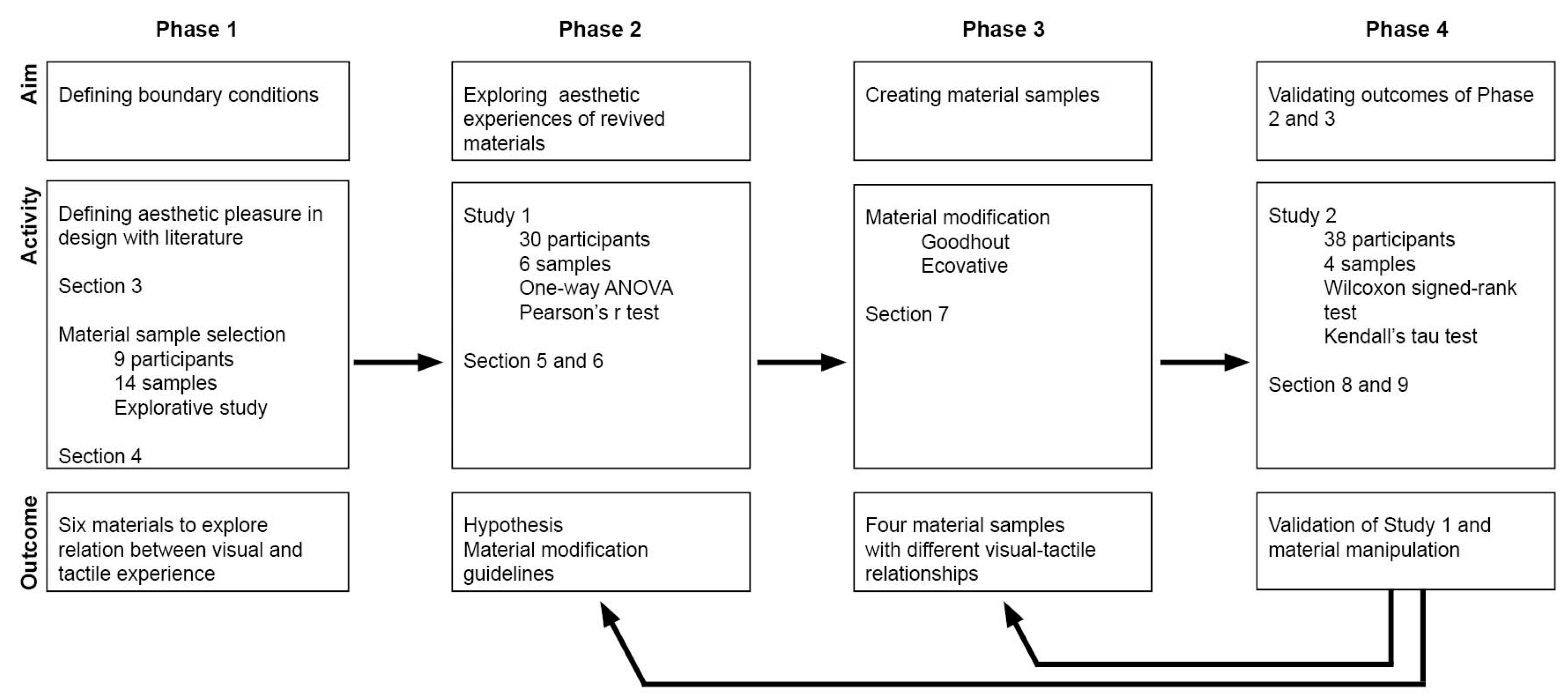
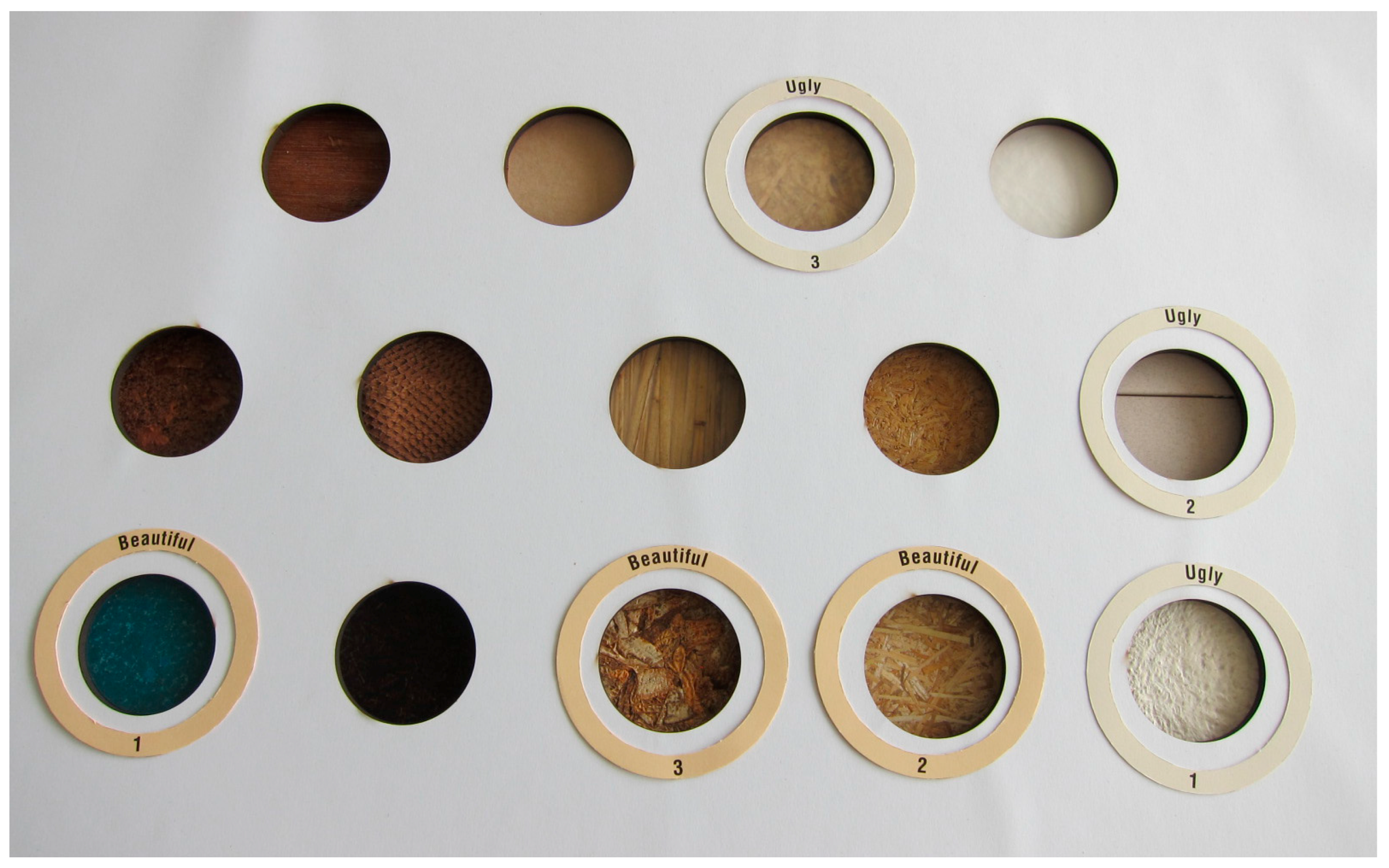
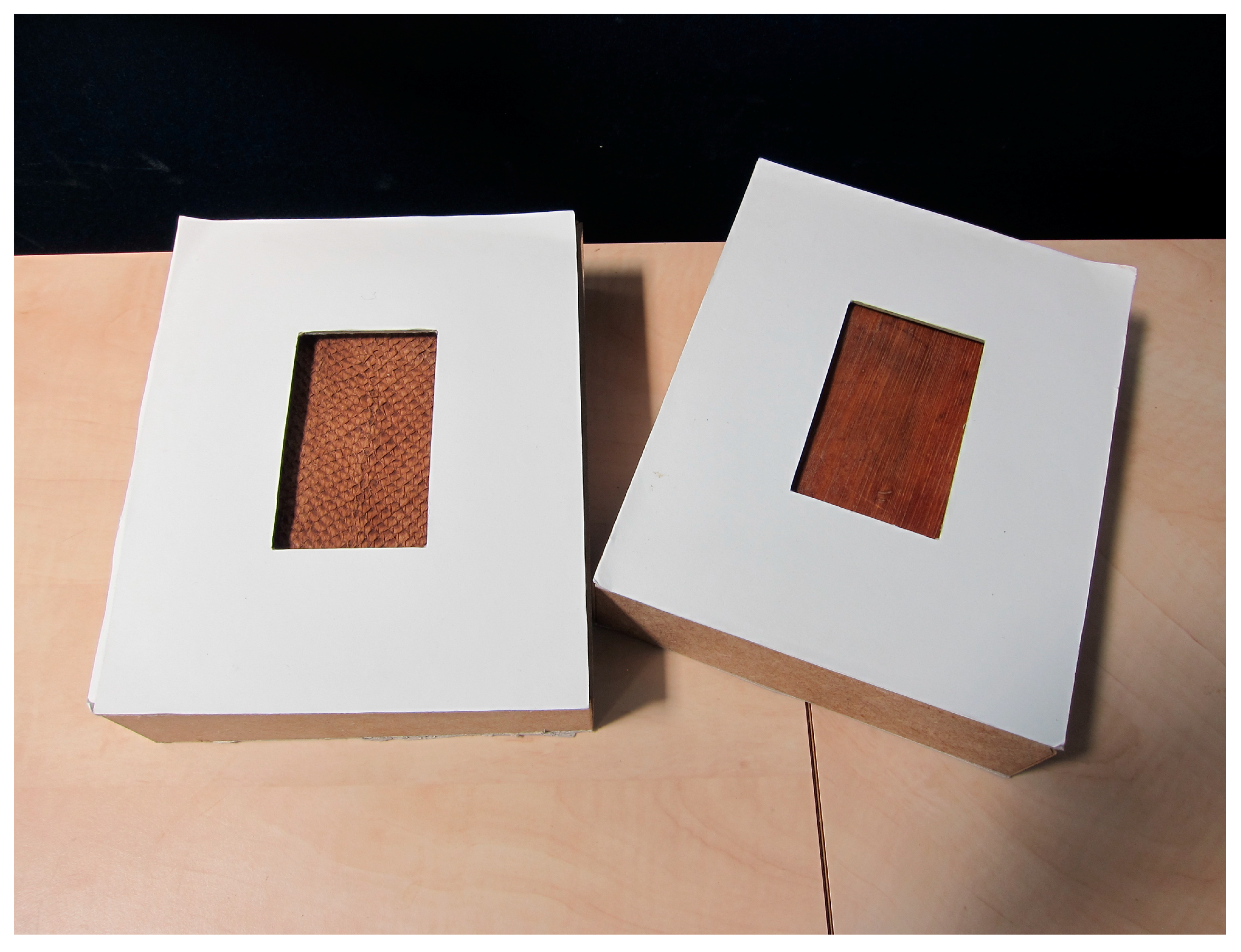
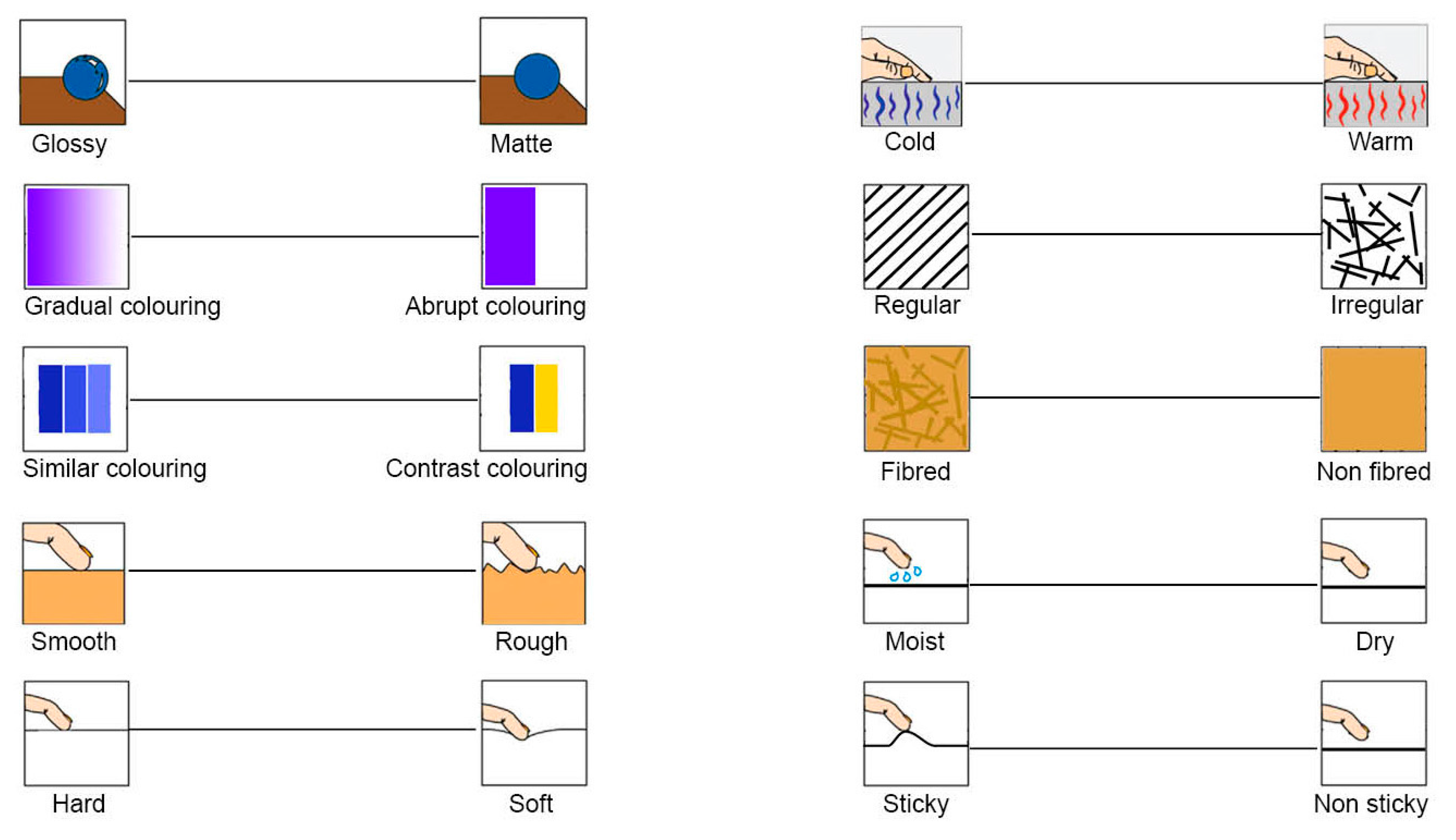
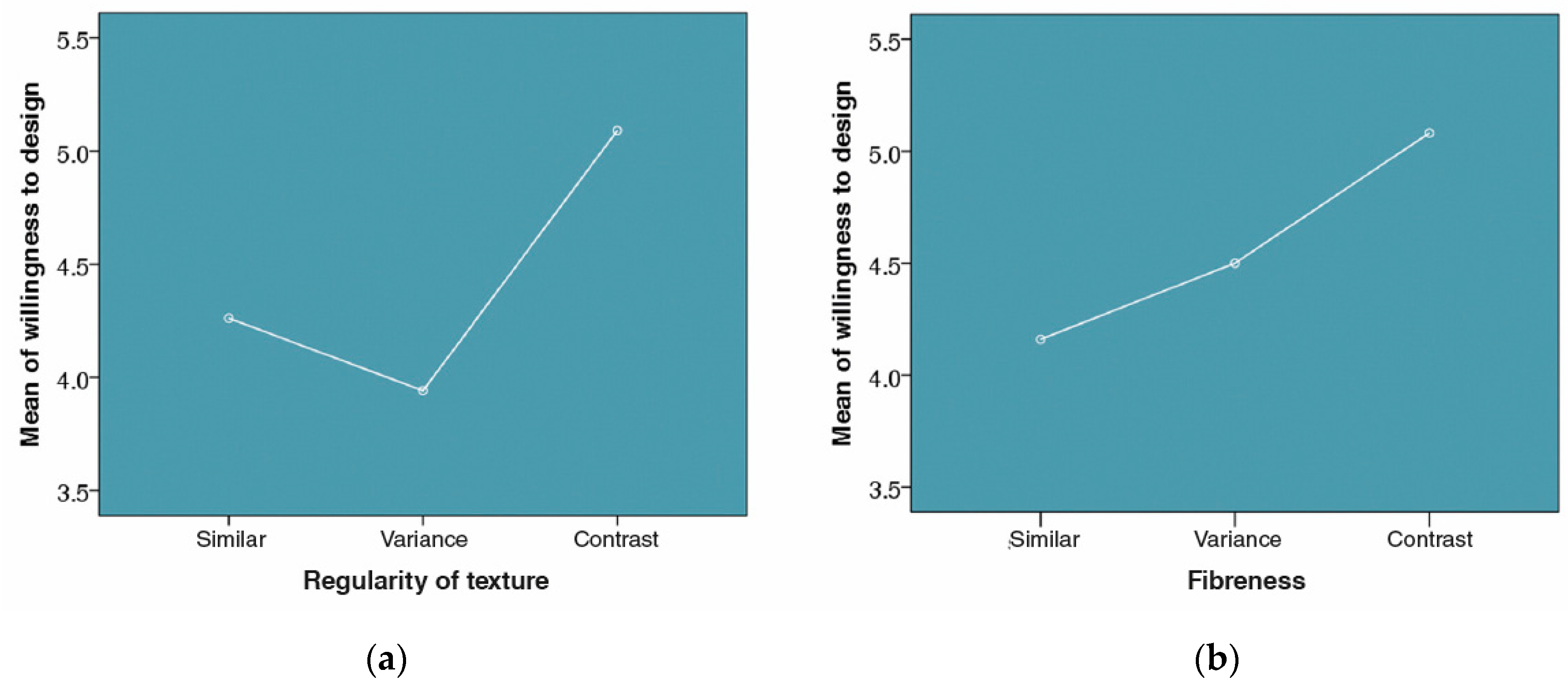

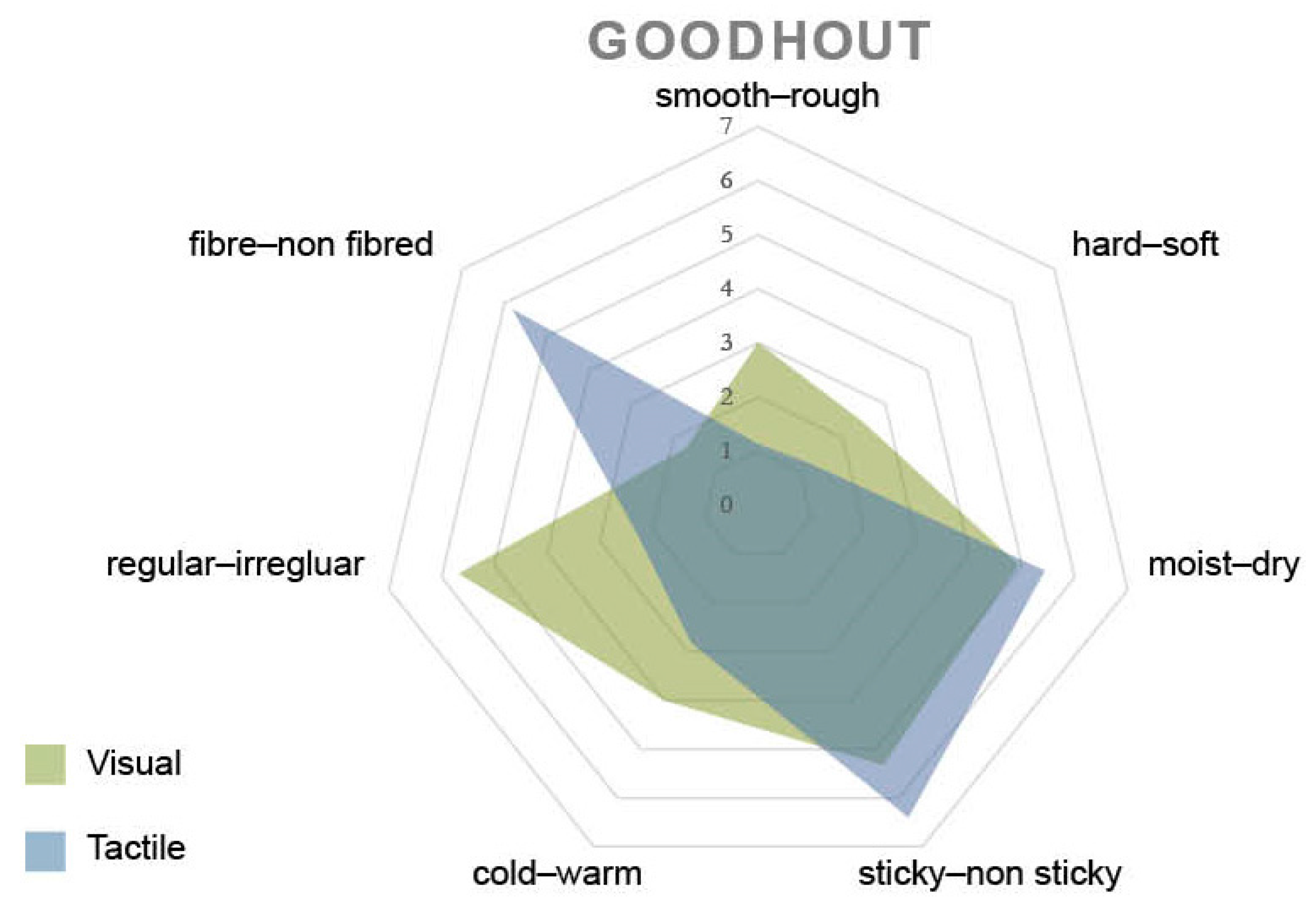
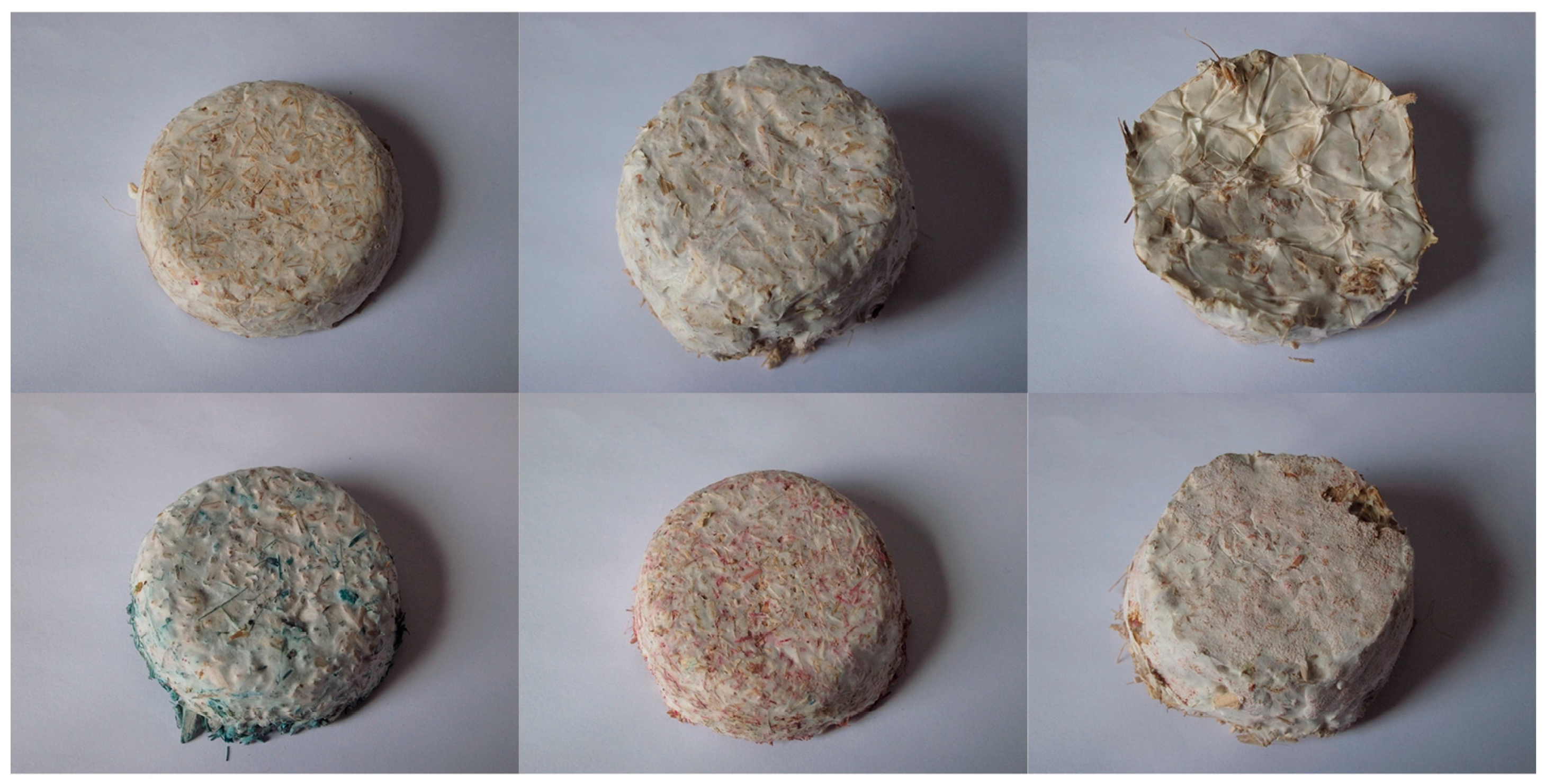
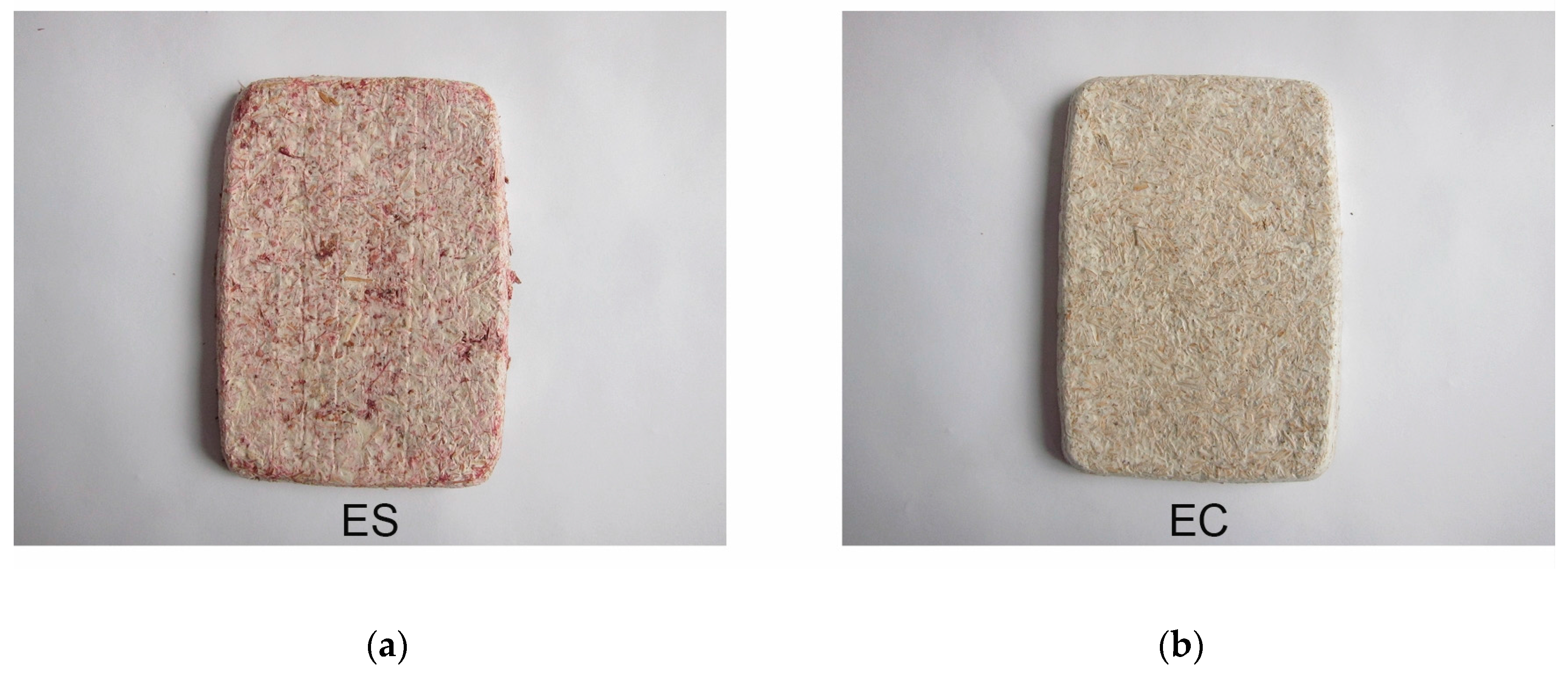
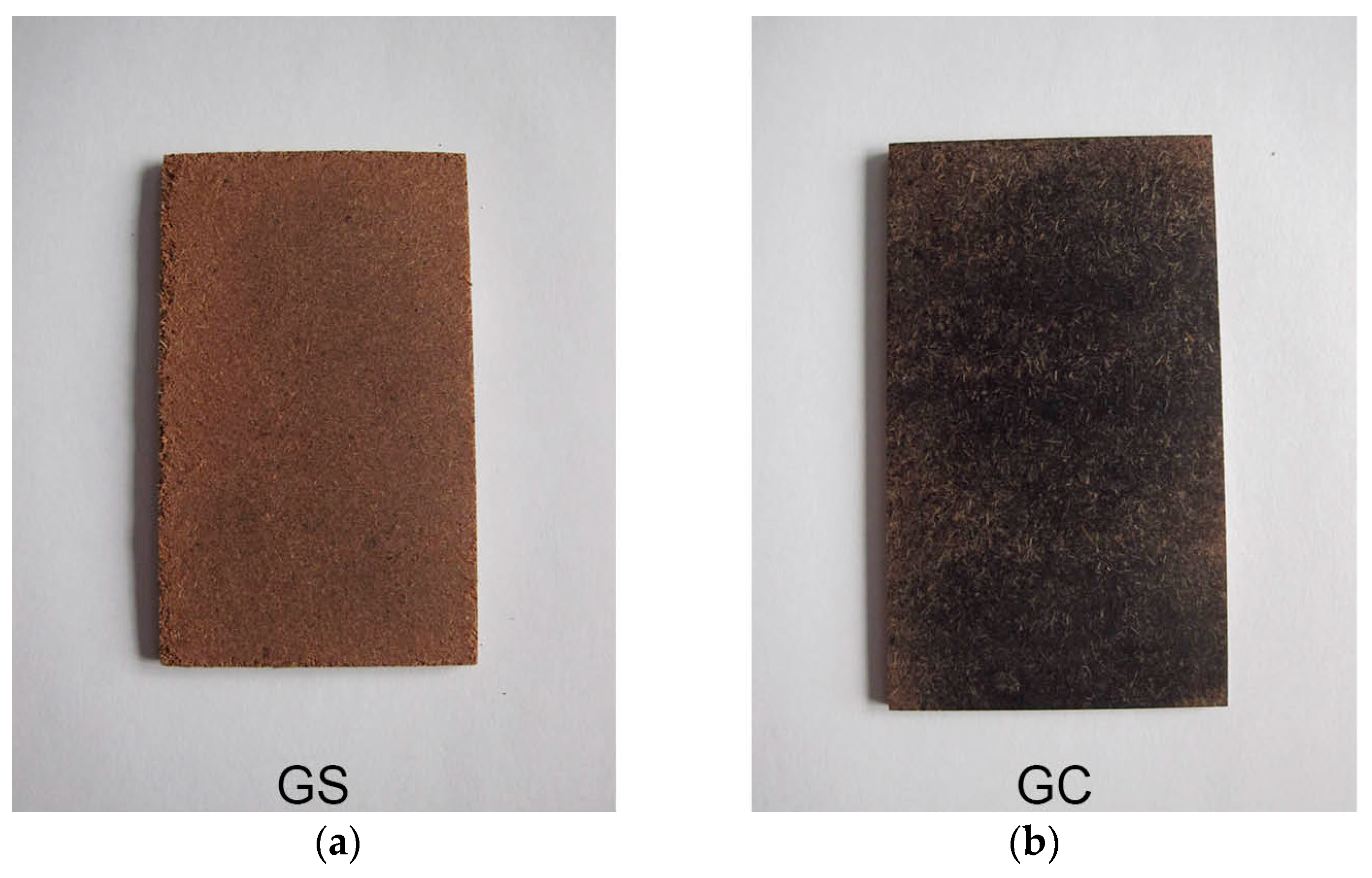
| Universals that Create Unity | Universals that Allow Variety |
|---|---|
| Symmetry | Originality |
| Simplicity Similarity | Contrast Peak-shift principle Solving puzzles |
| Scale | Boundaries |
|---|---|
| Similar | ≤1 |
| Contrast | V > 4 and T < 4 or vice versa, V = 1 and T = 4 or V = 7 and T = 4 |
| Variance | Relation V–T ≠ boundaries of Similar or Contrast |
| Dependent Variable | Regularity of Texture | Regularity of Texture | Mean Difference (I-J) | Std. Error | Sig. | 95% Confidence Interval | ||
|---|---|---|---|---|---|---|---|---|
| Lower Bound | Upper Bound | |||||||
| Willingness to design | Hochberg | Similar | Variance Contrast | 0.320 −0.829 | 0.413 0.312 | 823 0.026 | −0.68 −0.1.58 | 1.32 −0.08 |
| Variance | Similar Contrast | −0.320 −1.150 | 0.413 0.479 | 0.823 0.051 | −1.23 −2.30 | 0.68 0.00 | ||
| Dependent Variable | Fibreness | Fibreness | Mean Difference (I-J) | Std. Error | Sig. | 95% Confidence Interval | ||
|---|---|---|---|---|---|---|---|---|
| Lower Bound | Upper Bound | |||||||
| Willingness to design | Hochberg | Similar | Variance Contrast | 0.340 −0.921 | 0.403 0.299 | 0.783 0.007 | −1.31 −0.1.64 | 0.63 −0.20 |
| Variance | Similar Contrast | −0.340 −0.581 | 0.403 0.459 | 0.783 0.501 | −0.63 −1.69 | 1.31 0.53 | ||
| Gradual-Abrupt Colour Change | Similar-Contrasting Colour Change | Glossy-Matte | ||
|---|---|---|---|---|
| Smooth–rough | Pearson Correlation | 0.203 | -0.051 | 0.193 |
| Sig. (2-tailed) | 0.008 | 0.512 | 0.009 | |
| n | 170 | 170 | 180 | |
| Hard–soft | Pearson Correlation | −0.080 | −0.058 | 0.073 |
| Sig. (2-tailed) | 0.299 | 0.45 | 0.392 | |
| n | 170 | 170 | 180 | |
| Moist–dry | Pearson Correlation | −0.138 | −0.118 | 0.211 |
| Sig. (2-tailed) | 0.072 | 0.125 | 0.004 | |
| n | 170 | 170 | 180 | |
| Sticky–non sticky | Pearson Correlation | −0.161 | −0.151 | 0.213 |
| Sig. (2-tailed) | 0.036 | 0.05 | 0.004 | |
| n | 170 | 170 | 180 | |
| Cold–warm | Pearson Correlation | 0.028 | −0.033 | 0.17 |
| Sig. (2-tailed) | 0.718 | 0.673 | 0.023 | |
| n | 170 | 170 | 180 | |
| Regular–irregular | Pearson Correlation | 0.26 | 0.295 | 0.011 |
| Sig. (2-tailed) | 0.001 | 0 | 0.885 | |
| n | 170 | 170 | 180 | |
| Fibred–non fibred | Pearson Correlation | −0.293 | −0.198 | 0.15 |
| Sig. (2-tailed) | 0 | 0.01 | 0.045 | |
| n | 170 | 170 | 180 |
| Tactile Quality | Visual Quality |
|---|---|
| Smooth | Gradual colouring and glossy |
| Rough | Abrupt colouring and matte |
| Moist | Glossy |
| Dry | Matte |
| Sticky | Abrupt and contrasting colouring, glossy |
| Non sticky | Gradual and similar colouring, matte |
| Cold | Glossy |
| Warm | Matte |
| Regularity of texture | Gradual and similar colouring |
| Irregularity of texture | Abrupt and contrasting colouring |
| Fibred | Abrupt and contrasting colouring, glossy |
| Non fibred | Gradual and similar colouring, matte |
| EC_Similar–ES_Similar | EC_Expected–ES_Expected | GC_Similar–GS_Similar | GC_Expected–GS_Expected | |
|---|---|---|---|---|
| Z | −0.313 | −0.318 | −3.658 | −4.487 |
| Asymptotic. Sig. (2-tailed) | 0.754 | 0.750 | 0.000 | 0.000 |
| GC_Beauty–GS_Beauty | GC_Design–GS_Design | |
|---|---|---|
| Z | −2.319 | −0.992 |
| Asymptotic. Sig. (2-tailed) | 0.020 | 0.321 |
© 2017 by the authors. Licensee MDPI, Basel, Switzerland. This article is an open access article distributed under the terms and conditions of the Creative Commons Attribution (CC BY) license (http://creativecommons.org/licenses/by/4.0/).
Share and Cite
,, M.S.; Karana, E.; Rognoli, V. Revived Beauty: Research into Aesthetic Appreciation of Materials to Valorise Materials from Waste. Sustainability 2017, 9, 529. https://doi.org/10.3390/su9040529
, MS, Karana E, Rognoli V. Revived Beauty: Research into Aesthetic Appreciation of Materials to Valorise Materials from Waste. Sustainability. 2017; 9(4):529. https://doi.org/10.3390/su9040529
Chicago/Turabian Style,, Marita Sauerwein, Elvin Karana, and Valentina Rognoli. 2017. "Revived Beauty: Research into Aesthetic Appreciation of Materials to Valorise Materials from Waste" Sustainability 9, no. 4: 529. https://doi.org/10.3390/su9040529




